Bearberry
| Bearberry | ||||||||||||
|---|---|---|---|---|---|---|---|---|---|---|---|---|
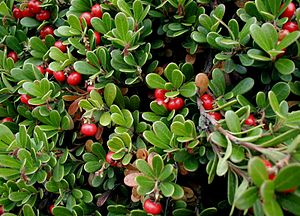
Real bearberry ( Arctostaphylos uva-ursi ), with fruits |
||||||||||||
| Systematics | ||||||||||||
|
||||||||||||
| Scientific name | ||||||||||||
| Arctostaphylos | ||||||||||||
| Adans. |
The bearberry ( Arctostaphylos ) are a genus within the family of the heather family (Ericaceae). Most of the approximately 66 species are common in western North America .
description
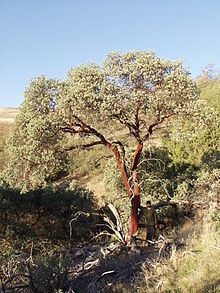




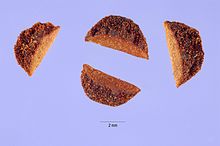
Appearance and leaves
The Arctostaphylos species are evergreen, woody plants and grow as dwarf shrubs , shrubs or small trees . For example, Arctostaphylos manzanita , Arctostaphylos hooveri and Arctostaphylos glauca reach heights of growth of 1 to 8 meters as a shrub to small tree, which should be the maximum height in the genus Arctostaphylos . The two species occurring in Central Europe form only recumbent espalier bushes . Depending on the species, they survive bush fires or are killed in the process (see under ecology). The above-ground parts of the plant can have multicellular trichomes . The branches are prostrate or independently upright. The bark is reddish depending on the type, relatively thin and peels off quickly or (with Arctostaphylos morroensis , Arctostaphylos nissenana , Arctostaphylos nummularia , Arctostaphylos osoensis , Arctostaphylos pajaroensis , Arctostaphylos rudis , Arctostaphylos tomentosa ) it is durable, gray, rough and cracked. The bark of the branches is bare or hairy, sometimes glandular ( indument ).
The alternate, usually spread, sometimes upright on the branches arranged leaves are in short petiole and leaf blade divided; in some species no petiole is recognizable. In the few species where the petiole is relatively short, the leaves overlap. The leaves are mostly isofacial (both surfaces the same), sometimes bifacial (leaf surfaces different), with regard to the arrangement of the stomata , color and hairiness (trichomes). The simple, leathery, flat to convex leaf blades are ovate to elliptical. The leaf margin is usually entire or finely serrated (for example in Arctostaphylos pacifica ) or is rarely ciliated; it is mostly flat, rarely curved back. The smooth to papillary or rough leaf surface can be bald or hairy.
Inflorescences and flowers
In most species, an inflorescence remains for four to six months from late spring to winter until the beginning of flowering (with Arctostaphylos pringlei subsp. Drupacea it is different). In terminal simple and traubigen or branched and rispigen (the panicle are similar grapes) inflorescences are usually 5 to 20, rarely up to 50 nodding flowers more or less close together. The tan to light brown bracts are mostly durable (with Arctostaphylos pringlei they fall off after anthesis ) and either scale-shaped, triangular or ovoid and sometimes keeled or they are leaf-like, narrow-lanceolate and flat. The bracts are much shorter than the sepals and in the bud stage are usually densely overlapping like roof tiles, but sometimes they are spread out and do not overlap. In Arctostaphylos and Arctous never bracts present in the other genera of the subfamily Arbutoideae however, they are present.
The hermaphroditic flowers are radial symmetry and five-fold (in Arctostaphylos nummularia , Arctostaphylos sensitiva four-fold) with a double flower envelope . The mostly five (with Arctostaphylos nummularia , Arctostaphylos sensitiva four) free and durable sepals are ovate to triangular. The mostly five (in Arctostaphylos nummularia , Arctostaphylos sensitiva four) petals are fused almost over their entire length to form a conical to jug or urn-shaped, early-sloping corolla, which ends in usually five, rarely four short corolla lobes. The colors of the petals range from white to pink. An intrastaminal nectar disc is present. There are two circles with rarely four or usually five free, fertile stamens each, which do not protrude above the corolla. The free, widened stamens are usually hairy at their base. Each mostly dark red anther has two, mostly bent back, thread-like appendages in the upper area and opens with a pore at the upper end. The upper permanent ovary is two to zehnkammerig and placentation is central angle constantly with only one ovule per ovary chamber. The straight stylus ends in a cephalic scar.
Fruits and seeds
The red, reddish-brown or brown drupes when ripe are spherical or indented spherical. The exocarp leathery or rarely thin and smooth. The mesocarp is mostly dry, floury or rarely absent. The endocarp contains several seeds. The one to ten stone cores can be fused. The one to ten seeds are free or in twos or threes along the radial surfaces of the stony endocarp, sometimes fused into a single sphere and sometimes triangular-ovoid.
Sets of chromosomes
The basic chromosome number is x = 13.
ecology
The Arctostaphylos species and the conifers occurring in these vegetation areas as well as other tree species that possess ectomycorrhiza form a highly diverse mycorrhizal community. Mycorrhizal communities with the trees and bushes and the relatively frequent bush fires are the main causes of the main limited range of the genus Arctostaphylos . About a third of the Arctostaphylos species have a thickened, woody area at the base of the trunk, which forms dormant buds, or there are growth nodes on the creeping trunks in root-forming areas; With both morphological adaptations, a new shoot takes place after a bush fire, when the crown has been destroyed. In the case of the other species, the entire specimen is destroyed in bush fires and the populations regenerate from the diaspore bank in the soil.

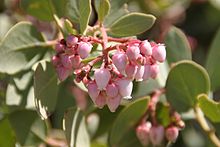



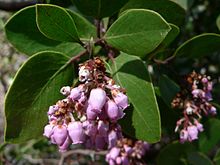

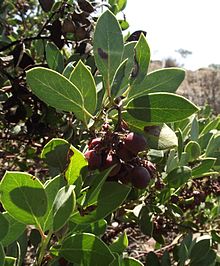
Occurrence
Of the approximately 66 species, 62 occur in North America. The distribution area ranges from North America to Mexico to Central America and a few species occur in Eurasia. No species are naturally common on the other continents. In Central Europe , only the two species of real bearberry ( Arctostaphylos uva-ursi ) and Alpine bearberry ( Arctostaphylos alpina ) are native.
Almost all Arctostaphylos species thrive in the so-called California Floral Province from southern Oregon to northern Baja California to Mexico. The focus of the species diversity of the genus Arctostaphylos lies with about half of all species along the central California coast. Many of the Arctostaphylos species found in North to Central America are named in their manzanita .
Along the central California coast, most of the Arctostaphylos species thrive in vegetation formations that are heavily influenced by summer mist; this applies to the species that grow in the maritime chaparral , on the edges of forests or in wooded areas, such as the bishop's pine ( Pinus muricata ) and forests occurrence. Arctostaphylos species not found in the Pacific Coast area thrive on the edges of the desert in chaparral woodlands and forests.
Most Arctostaphylos species thrive in nutrient-poor and acidic soils .
Systematics
The genus Arctostaphylos was established by Michel Adanson in 1763 . Type species is Arctostaphylos uva-ursi (L.) Spreng. Synonyms for Arctostaphylos Adans. are: Daphnidostaphylis Klotzsch , Xerobotrys Nutt. , Mairania Neck. , Schizococcus Eastw. , Uva-ursi Duhamel , Uva-ursi Mill. , Uva-ursi Moench . The genus name Arctostaphylos is derived from Greek words arktos for bear and staphyle for "bunch of grapes" and refers to the name of bearberry (bearberry) the nature Arctostaphylos uva-ursi .
The genus Arctostaphylos belongs to the subfamily Arbutoideae within the family of Ericaceae .
There are around 66 species of Arctostaphylos :
- Alpine bearberry ( Arctostaphylos alpina (L.) Spreng. )
- Arctostaphylos andersonii A.Gray : It occurs in California.
- Arctostaphylos auriculata Eastw. : It occurs in California.
- Arctostaphylos australis Eastw.
- Arctostaphylos bakeri Eastw. : It occurs in two subspecies in California.
- Arctostaphylos bolensis P.V.Wells
- Arctostaphylos canescens Eastw. : It occurs in two subspecies in California and southwestern Oregon.
- Arctostaphylos catalinae P.V.Wells : It occurs on Santa Catalina Island in California.
- Arctostaphylos caucasica Lipsch.
- Arctostaphylos columbiana Piper : It occurs in British Columbia, Oregon, Washington and California.
- Arctostaphylos confertiflora Eastw. : It occurs in California.
- Arctostaphylos crustacea Eastwood : It occurs in six subspecies in California.
- Arctostaphylos cruzensis Roof : It occurs in California.
- Arctostaphylos densiflora M.S.Baker : It occurs in California.
- Arctostaphylos edmundsii J.T. Howell : It occurs in California.
- Arctostaphylos franciscana Eastwood : It occurs in California.
- Arctostaphylos gabilanensis V.T. Parker & MCVasey : It occurs in California.
- Arctostaphylos glandulosa Eastw. : It occurs in eight subspecies in California, Oregon and Baja California .
- Arctostaphylos glauca Lindl. : It occurs in California and northern Mexico.
- Arctostaphylos glutinosa B. Writ. : It occurs in California.
- Arctostaphylos hispidula Howell : It occurs in California and Oregon.
- Arctostaphylos hookeri G.Don : It occurs in five subspecies in California.
- Arctostaphylos hooveri P.V.Wells : It occurs in California.
- Arctostaphylos imbricata Eastw. : It occurs in California.
- Arctostaphylos incognita J.E. Keeley & al.
- Arctostaphylos insularis Greene & Parry : It occurs in California.
- Arctostaphylos klamathensis S.W. Edwards, Keeler-Wolf & W.Knight : It occurs in California.
- Arctostaphylos luciana P.V.Wells : It occurs in California.
- Arctostaphylos malloryi (W.Knight & Gankin) PVWells : It occurs in California.
- Arctostaphylos manzanita Parry : It occurs in six subspecies in California.
- Arctostaphylos mendocinoensis P.V. Wells
- Arctostaphylos mewukka Merriam : It occurs in two subspecies in California.
- Arctostaphylos montana Eastwood : It occurs in two subspecies in California.
- Arctostaphylos montaraensis Roof : It occurs in California.
- Arctostaphylos montereyensis Hoover : It occurs in California.
- Arctostaphylos moranii P.V Wells
- Arctostaphylos morroensis Wiesl. & B. Write. : It occurs in California.
- Arctostaphylos myrtifolia Parry : It occurs in California.
- Arctostaphylos nevadensis A.Gray : It occurs in two subspecies in Oregon, Washington, Nevada and California.
- Arctostaphylos nissenana Merriam : It occurs in California.
- Arctostaphylos nortensis (PVWells) PVWells : It occurs in California and Oregon.
- Arctostaphylos novoleontis Rehder
- Arctostaphylos nummularia A.Gray : It occurs in two subspecies in California.
- Arctostaphylos obispoensis Eastw. : It occurs in California.
- Arctostaphylos ohloneana M.C. Vasey & VTParker : It occurs in California.
- Arctostaphylos osoensis P.V.Wells : It is found in California.
- Arctostaphylos otayensis Wiesl. & B. Write. : It occurs in California.
- Arctostaphylos pacifica Roof : It occurs in California.
- Arctostaphylos pajaroensis J.E. Adams : It occurs in California.
- Arctostaphylos pallida Eastw. : It occurs in California.
- Arctostaphylos parryana Lemmon : It occurs in three subspecies in California.
- Arctostaphylos patula Greene (Syn .: Arctostaphylos acutifolia Eastw. ): It occurs in Oregon, Washington, Montana, Colorado, Nevada, California, Arizona and in northern Mexico.
- Arctostaphylos pechoensis (Abrams) Dudley ex Abrams : It occurs in California.
- Arctostaphylos peninsularis P.V. Wells
- Arctostaphylos pilosula Jeps. & Wiesl. : It occurs in California.
- Arctostaphylos pringlei Parry : It occurs in two subspecies in Arizona, Nevada, Utah, California and Baja California.
- Arctostaphylos pumila Nutt. : It occurs in California.
- Arctostaphylos pungens Kunth : It occurs in California, Utah, Arizona, New Mexico and Texas.
- Arctostaphylos purissima P.V.Wells : It occurs in California.
- Arctostaphylos rainbowensis J.E. Keeley & Massihi : It occurs in California.
- Arctostaphylos refugioensis Gankin : It occurs in California.
- Arctostaphylos regismontana Eastw. : It occurs in California.
- Arctostaphylos rudis Jeps. & Wiesl. : It occurs in California.
- Arctostaphylos sensitiva Jepson : It occurs in California.
- Arctostaphylos silvicola Jeps. & Wiesl. : It occurs in California.
- Arctostaphylos stanfordiana Parry : It occurs in three subspecies in California.
- Arctostaphylos tomentosa (Pursh) Lindl. : It occurs in four subspecies in California.
- Real bearberry , evergreen bearberry ( Arctostaphylos uva-ursi (L.) Spreng. ): It is widespread in the northern hemisphere in Eurasia and from North America to Central America (Guatemala).
- Arctostaphylos virgata Eastw. : It occurs in California.
- Arctostaphylos viridissima (Eastw.) McMinn : It occurs in California.
- Arctostaphylos viscida Parry : It occurs in three subspecies in Oregon and California.
- Arctostaphylos wellsii W.Knight : It was first described from California.
swell
- V. Thomas Parker, Michael C. Vasey, Jon E. Keeley: Arctostaphylos. , P. 406 - the same text online as the printed work , In: Flora of North America Editorial Committee (Ed.): Flora of North America North of Mexico. Volume 8: Paeoniaceae to Ericaceae , Oxford University Press, New York and Oxford, 2009. ISBN 978-0-19-534026-6
- V. Thomas Parker, Michael C. Vasey, Jon E. Keeley: Description and identification key of Arctostaphylos at Jepson eFlora .
Individual evidence
- ↑ a b c d e f g h i j k l m n o p q r s t u v w x y z aa ab ac ad ae af ag ah ai aj ak al am an ao ap aq ar as at au av aw ax ay az ba bb bc bd be bf bg bh bi bj bk bl bm bn V. Thomas Parker, Michael C. Vasey, Jon E. Keeley: Arctostaphylos. , P. 406 - the same text online as the printed work , In: Flora of North America Editorial Committee (Ed.): Flora of North America North of Mexico. Volume 8: Paeoniaceae to Ericaceae , Oxford University Press, New York and Oxford, 2009. ISBN 978-0-19-534026-6
- ↑ a b c d Gordon C. Tucker: Ericaceae Jussieu subfam. Arbutoideae Niedenzu. , P. 406 - the same text online as the printed work , In: Flora of North America Editorial Committee (Ed.): Flora of North America North of Mexico. Volume 8: Paeoniaceae to Ericaceae , Oxford University Press, New York and Oxford, 2009. ISBN 978-0-19-534026-6
- ↑ a b c d e f g h i j k l m n o V. Thomas Parker, Michael C. Vasey, Jon E. Keeley: Description and identification key of Arctostaphylos at Jepson eFlora .
- ^ A b Manfred A. Fischer , Wolfgang Adler, Karl Oswald: Excursion flora for Austria, Liechtenstein and South Tyrol. 2nd, improved and enlarged edition. State of Upper Austria, Biology Center of the Upper Austrian State Museums, Linz 2005, ISBN 3-85474-140-5 .
- ^ Arctostaphylos at Tropicos.org. In: IPCN Chromosome Reports . Missouri Botanical Garden, St. Louis
- ^ Siegmund Seybold (Ed.): Schmeil-Fitschen interactive. CD-ROM, Version 1.1, Quelle & Meyer, Wiebelsheim 2002, ISBN 3-494-01327-6 .
- ^ Adanson scanned in 1763 at biodiversitylibrary.org .
- ^ Arctostaphylos at Tropicos.org. Missouri Botanical Garden, St. Louis, accessed July 29, 2014.
- ↑ a b c d e f g h i j k l m n o p q r s t u v Arctostaphylos in the Germplasm Resources Information Network (GRIN), USDA , ARS , National Genetic Resources Program. National Germplasm Resources Laboratory, Beltsville, Maryland. Retrieved October 11, 2017.
Web links
- JL Luteyn: Arctostaphylos at Tropicos.org. In: Flora Mesoamericana . Missouri Botanical Garden, St. Louis
- Arctostaphylos at Tropicos.org. In: Flora of Panama (WFO) . Missouri Botanical Garden, St. Louis
- Species list on ITIS.
- Richard J. Vogl, Paul Schorr: Fire and manzanita chaparral in the San Jacinto Mountains, California. In: Ecology , Volume 53, No. 6, 1972, pp. 1179-1188.
Note: Known as Manzanita, was Arctostaphylos glandulosa . JSTOR 1935432 - Illustrations of Arctostaphylos species from the Flora of North America North of Mexico : Illustration: Arctostaphylos , Illustration: Arctostaphylos , Illustration: Arctostaphylos
